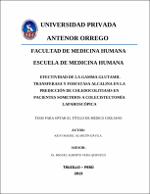Efectividad de la gamma glutamil transferasa y fosfatasa alcalina en la predicción de coledocolitiasis en pacientes sometidos a colecistectomía laparoscópica

Ver/
Descargar
(application/pdf: 463.7Kb)
(application/pdf: 463.7Kb)
Fecha
2015Autor(es)
Alarcon Davila, Keivi Madiel
Metadatos
Mostrar el registro completo del ítemResumen
Determinar la efectividad de la gamma glutamil transferasa y fosfatasa alcalina en la predicción de colédocolitiasis en pacientes sometidos a colecistectomía laparoscópica en el Hospital Belén de Trujillo durante el periodo de Enero del 2010 a Diciembre del 2014.
MATERIAL Y MÉTODO: Realizamos un estudio observacional, analítico, de pruebas diagnósticas, que evaluó 70 pacientes > 18 años de edad admitidos por Emergencia por colecistitis litiásica aguda.
RESULTADOS: La edad promedio en los pacientes con y sin colédocolitiasis fueron 51 ± 26,57 años y 43,30 ± 15,66 años respectivamente; así mismo el 33,33% y 23,44% fueron varones respectivamente. El diámetro ultrasonográfico fue 12,38 ± 1,50 mm y 6,86 ± 2,63 mm en los grupos con y sin colédocolitiasis. Los promedios de la GGT (99,50 ± 28,49 y 54,97 ± 22,82 IU/L) y FA (483,17 ± 163,86 y 178,56 ± 76,33 IU/L) respectivamente (p < 0,001). A un punto de corte > 50 para la GGT, la sensibilidad, especificidad, VPP y VPN fueron 83,33%, 64,06%, 17,86% y 97,62% respectivamente; y con un punto de corte > 300 para la FA, la sensibilidad, especificidad, VPP y VPN fueron 83,33%, 96,88%, 71,43% y 98,41% respectivamente. Al calcular el área bajo la curva (a través de la curva ROC) de la gamma glutamil transpeptidasa, la fosfatasa alcalina y la presencia de colédocolitiasis, se tuvieron los siguientes valores: Área bajo la curva: (GGT = 0,852 y FA = 0,906).
CONCLUSIONES: Las dos enzimas si tuvieron criterios predictivos para el diagnóstico de colédocolitiasis, siendo más efectiva la fosfatasa alcalina. Determine the effectiveness of gamma glutamyl transferase and
alkaline phosphatase in predicting choledocholithiasis in patients undergoing
laparoscopic cholecystectomy in the Bethlehem Hospital of Trujillo during the
period January 2010 to December 2014.
MATERIAL AND METHODS: We conducted an observational, analytical,
diagnostic test study, which evaluated 70 patients > 18 years of age admitted at
emergency for acute cholecystitis.
RESULTS: The mean age of patients with and without choledocholithiasis
were 51 ± 26.57 years and 43.30 ± 15.66 years respectively; similarly 33.33%
and 23.44% were males respectively. The ultrasonographic diameter was 12.38
± 1.50 mm and 6.86 ± 2.63 mm in the groups with and without
choledocholithiasis. The means of GGT (99.50 ± 28.49 and 54.97 ± 22.82 IU /
L) and FA (483.17 ± 163.86 and 178.56 ± 76.33 IU / L), respectively (p <
0.001). A cutoff > 50 for GGT, sensitivity, specificity, PPV and NPV were
83.33%, 64.06%, 17.86% and 97.62% respectively; and a cutoff of > 300 for
the FA, the sensitivity, specificity, PPV and NPV were 83.33%, 96.88%,
71.43% and 98.41% respectively. In calculating the area under the curve
(through the ROC curve) of gamma glutamyl transpeptidase, alkaline
phosphatase and the presence of choledocholithiasis, the following values were
taken, area under the curve: (GGT = 0.852 and FA = 0.906).
CONCLUSIONS: If the two enzymes had predictive criteria for diagnosing
choledocholithiasis, being more effective alkaline phosphatase.
Palabras clave
Colecciones
- Medicina Humana [2969]

